Parameter Estimation-Based Slime Mold Algorithm of Photocatalytic Methane Reforming Process for Hydrogen Production
Abstract
:1. Introduction
- A consistent ANFIS model was established based on measured data of the photocatalytic methane reforming process for hydrogen production.
- A new application of the slime mold algorithm was suggested to find the optimum values of irradiation time, metal loading, methane concentration, and steam concentration.
- Hydrogen production was boosted.
2. Experimental Work
3. Proposed Methodology
3.1. ANFIS-Modelling
| (Output Layer) | |
| (Defuzzification Layer) | |
| (N Layer) | |
| (π Layer) | |
| (Fuzzification Layer) |
3.2. Optimization Algorithms
3.2.1. Slime Mold Algorithm
Mechanism 1: Approach Food
Mechanism 2: Wrap Food
Mechanism 3: Oscillation
4. Results and Discussion
4.1. ANFIS-Based Results
4.2. Optimization-Based RESULTS
5. Conclusions
Author Contributions
Funding
Institutional Review Board Statement
Informed Consent Statement
Data Availability Statement
Acknowledgments
Conflicts of Interest
References
- Wilberforce, T.; Olabi, A.G.; Sayed, E.T.; Elsaid, K.; Abdelkareem, M.A. Progress in carbon capture technologies. Sci. Total Environ. 2021, 761, 143203. [Google Scholar] [CrossRef] [PubMed]
- Olabi, A.G.; Obaideen, K.; Elsaid, K.; Wilberforce, T.; Sayed, E.T.; Maghrabie, H.M.; Abdelkareem, M.A. Assessment of the pre-combustion carbon capture contribution into sustainable development goals SDGs using novel indicators. Renew. Sustain. Energy Rev. 2022, 153, 111710. [Google Scholar] [CrossRef]
- Olabi, A.G.; Bahri, A.s.; Abdelghafar, A.A.; Baroutaji, A.; Sayed, E.T.; Alami, A.H.; Rezk, H.; Abdelkareem, M.A. Large-vscale hydrogen production and storage technologies: Current status and future directions. Int. J. Hydrog. Energy 2021, 46, 23498–23528. [Google Scholar] [CrossRef]
- Salameh, T.; Abdelkareem, M.A.; Olabi, A.G.; Sayed, E.T.; Al-Chaderchi, M.; Rezk, H. Integrated standalone hybrid solar PV, fuel cell and diesel generator power system for battery or supercapacitor storage systems in Khorfakkan, United Arab Emirates. Int. J. Hydrog. Energy 2021, 46, 6014–6027. [Google Scholar] [CrossRef]
- Abdelkareem, M.A.; Elsaid, K.; Wilberforce, T.; Kamil, M.; Sayed, E.T.; Olabi, A. Environmental aspects of fuel cells: A review. Sci. Total Environ. 2021, 752, 141803. [Google Scholar] [CrossRef]
- Abdelkareem, M.A.; Lootah, M.A.; Sayed, E.T.; Wilberforce, T.; Alawadhi, H.; Yousef, B.A.A.; Olabi, A.G. Fuel cells for carbon capture applications. Sci. Total Environ. 2021, 769, 144243. [Google Scholar] [CrossRef]
- Cano, Z.P.; Banham, D.; Ye, S.; Hintennach, A.; Lu, J.; Fowler, M.; Chen, Z. Batteries and fuel cells for emerging electric vehicle markets. Nat. Energy 2018, 3, 279–289. [Google Scholar] [CrossRef]
- Olabi, A.G.; Wilberforce, T.; Abdelkareem, M.A. Fuel cell application in the automotive industry and future perspective. Energy 2021, 214, 118955. [Google Scholar] [CrossRef]
- Diaz, E.; Epstein, M.; Romero, M.; González-Aguilar, J. Performance assessment of concentrated solar power plants based on carbon and hydrogen fuel cells. Int. J. Hydrog. Energy 2018, 43, 5852–5862. [Google Scholar] [CrossRef]
- Bicer, Y.; Khalid, F. Life cycle environmental impact comparison of solid oxide fuel cells fueled by natural gas, hydrogen, ammonia and methanol for combined heat and power generation. Int. J. Hydrog. Energy 2020, 45, 3670–3685. [Google Scholar] [CrossRef]
- Gao, J.; Wang, X.; Song, P.; Tian, G.; Ma, C. Review of the backfire occurrences and control strategies for port hydrogen injection internal combustion engines. Fuel 2022, 307, 121553. [Google Scholar] [CrossRef]
- Kim, H.; Song, S. Concept design of a novel reformer producing hydrogen for internal combustion engines using fuel decomposition method: Performance evaluation of coated monolith suitable for on-board applications. Int. J. Hydrog. Energy 2020, 45, 9353–9367. [Google Scholar] [CrossRef]
- Salameh, T.; Sayed, E.T.; Abdelkareem, M.A.; Olabi, A.; Rezk, H. Optimal selection and management of hybrid renewable energy System: Neom city as a case study. Energy Convers. Manag. 2021, 244, 114434. [Google Scholar] [CrossRef]
- Palhares, D.D.D.F.; Vieira, L.; Damasceno, J.J.R. Hydrogen production by a low-cost electrolyzer developed through the combination of alkaline water electrolysis and solar energy use. Int. J. Hydrogen Energy 2018, 43, 4265–4275. [Google Scholar] [CrossRef]
- Mahmoud, M.; Ramadan, M.; Naher, S.; Pullen, K.; Abdelkareem, M.A.; Olabi, A.-G. A review of geothermal energy-driven hydrogen production systems. Therm. Sci. Eng. Prog. 2021, 22, 100854. [Google Scholar] [CrossRef]
- Mostafaeipour, A.; Dehshiri, S.J.H. Ranking locations for producing hydrogen using geothermal energy in Afghanistan. Int. J. Hydrogen Energy 2020, 45, 15924–15940. [Google Scholar] [CrossRef]
- Boretti, A. Production of hydrogen for export from wind and solar energy, natural gas, and coal in Australia. Int. J. Hydrogen Energy 2020, 45, 3899–3904. [Google Scholar] [CrossRef]
- Ayodele, T.; Munda, J. Potential and economic viability of green hydrogen production by water electrolysis using wind energy resources in South Africa. Int. J. Hydrogen Energy 2019, 44, 17669–17687. [Google Scholar] [CrossRef]
- Nemmour, A.; Ghenai, C.; Inayat, A. Parametric study and optimization of bio-hydrogen production using steam reforming of glycerol and biodiesel fuel mixtures. Biomass. Convers. Biorefinery 2021, 1–13. [Google Scholar] [CrossRef]
- Ewan, B.; Allen, R. A figure of merit assessment of the routes to hydrogen. Int. J. Hydrogen Energy 2005, 30, 809–819. [Google Scholar] [CrossRef]
- Chen, S.; Pei, C.; Gong, J. Insights into interface engineering in steam reforming reactions for hydrogen production. Energy Environ. Sci. 2019, 12, 3473–3495. [Google Scholar] [CrossRef]
- Bepari, S.; Kuila, D. Steam reforming of methanol, ethanol and glycerol over nickel-based catalysts—A review. Int. J. Hydrogen Energy 2019, 45, 18090–18113. [Google Scholar] [CrossRef]
- Shagdar, E.; Lougou, B.G.; Shuai, Y.; Ganbold, E.; Chinonso, O.P.; Tan, H. Process analysis of solar steam reforming of methane for producing low-carbon hydrogen. RSC Adv. 2020, 10, 12582–12597. [Google Scholar] [CrossRef]
- Sayed, E.T.; Wilberforce, T.; Elsaid, K.; Rabaia, M.K.H.; Abdelkareem, M.A.; Chae, K.-J.; Olabi, A.G. A critical review on environmental impacts of renewable energy systems and mitigation strategies: Wind, hydro, biomass and geothermal. Sci. Total Environ. 2021, 766, 144505. [Google Scholar] [CrossRef] [PubMed]
- Rabaia, M.K.H.; Abdelkareem, M.A.; Sayed, E.T.; Elsaid, K.; Chae, K.-J.; Wilberforce, T.; Olabi, A. Environmental impacts of solar energy systems: A review. Sci. Total Environ. 2021, 754, 141989. [Google Scholar] [CrossRef]
- Obaideen, K.; AlMallahi, M.N.; Alami, A.H.; Ramadan, M.; Abdelkareem, M.A.; Shehata, N.; Olabi, A.G. On the contribution of solar energy to sustainable developments goals: Case study on Mohammed bin Rashid Al Maktoum Solar Park. Int. J. Thermoluids 2021, 12, 100123. [Google Scholar] [CrossRef]
- López-Martín, A.; Platero, F.; Caballero, A.; Colón, G. Thermo-Photocatalytic Methanol Reforming for Hydrogen Production over a CuPd−TiO 2 Catalyst. ChemPhotoChem 2020, 4, 630–637. [Google Scholar] [CrossRef]
- Yoshida, H.; Mizuba, S.; Yamamoto, A. Preparation of sodium hexatitanate photocatalysts by a flux method for photocatalytic steam reforming of methane. Catal. Today 2019, 334, 30–36. [Google Scholar] [CrossRef]
- Anzai, A.; Fujiwara, K.; Yamamoto, A.; Yoshida, H. Platinum-loaded lanthanum-doped calcium titanate photocatalysts prepared by a flux method for photocatalytic steam reforming of methane. Catal. Today 2020, 352, 1–9. [Google Scholar] [CrossRef]
- Shimura, K.; Yoshida, H. Semiconductor Photocatalysts for Non-oxidative Coupling, Dry Reforming and Steam Reforming of Methane. Catal. Surv. Asia 2014, 18, 24–33. [Google Scholar] [CrossRef] [Green Version]
- Ayodele, B.V.; Ghazali, A.A.; Yassin, M.Y.M.; Abdullah, S. Optimization of hydrogen production by photocatalytic steam methane reforming over lanthanum modified Titanium (IV) oxide using response surface methodology. Int. J. Hydrog. Energy 2019, 44, 20700–20710. [Google Scholar] [CrossRef]
- Li, S.; Chen, H.; Wang, M.; Heidari, A.A.; Mirjalili, S. Slime mould algorithm: A new method for stochastic optimization. Future Gener. Comput. Syst. 2020, 111, 300–323. [Google Scholar] [CrossRef]
- Abdelkareem, M.A.; Tanveer, W.H.; Sayed, E.; Assad, M.E.H.; Allagui, A.; Cha, S. On the technical challenges affecting the performance of direct internal reforming biogas solid oxide fuel cells. Renew. Sustain. Energy Rev. 2019, 101, 361–375. [Google Scholar] [CrossRef]
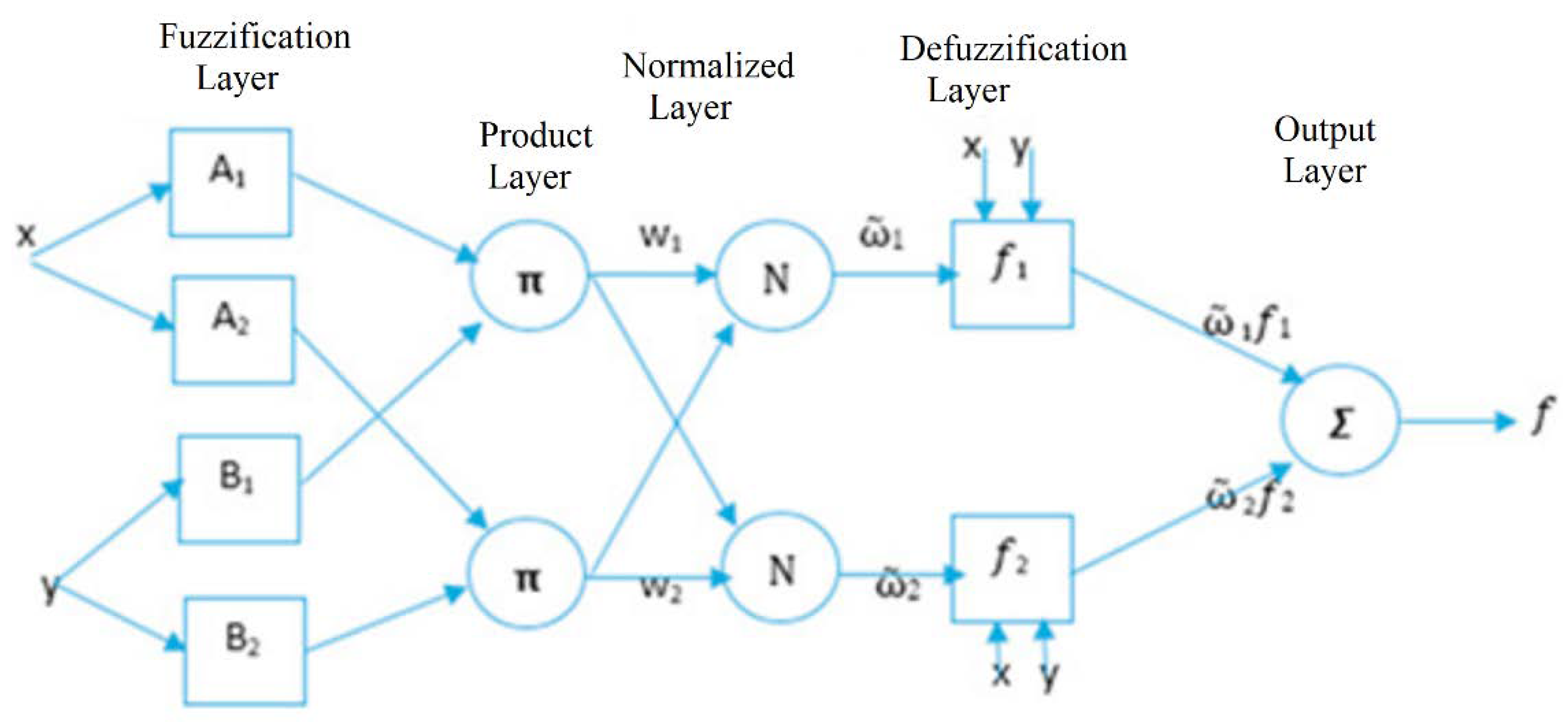
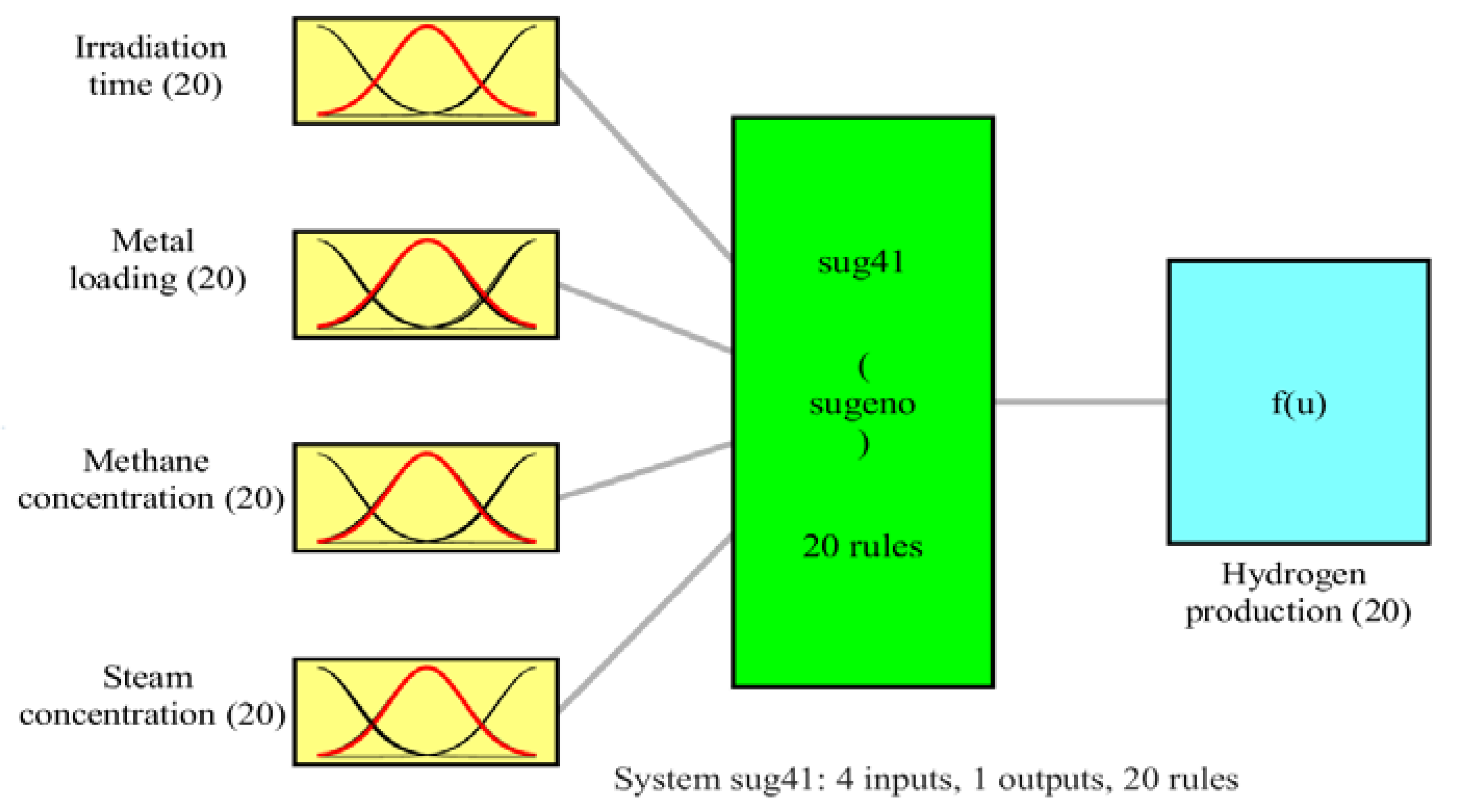
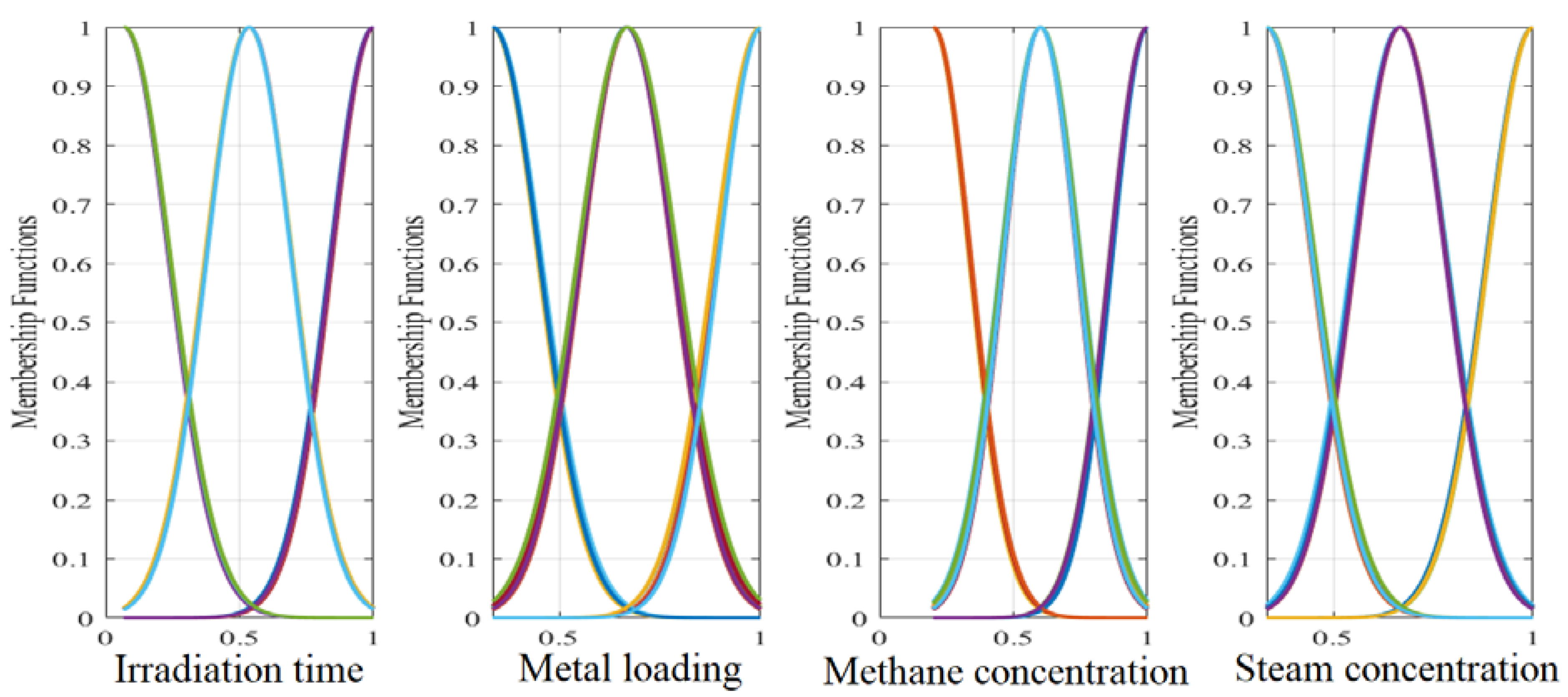
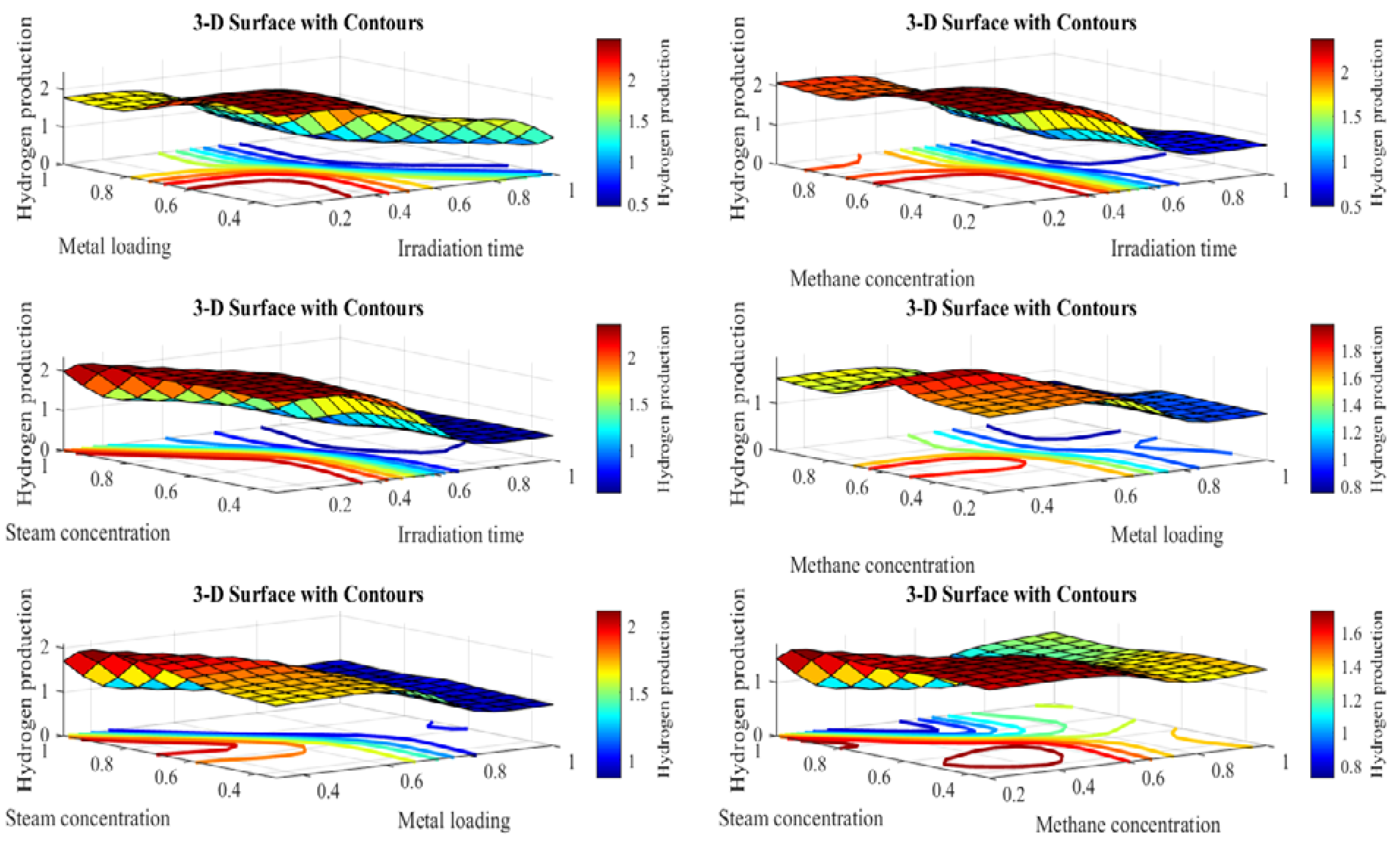
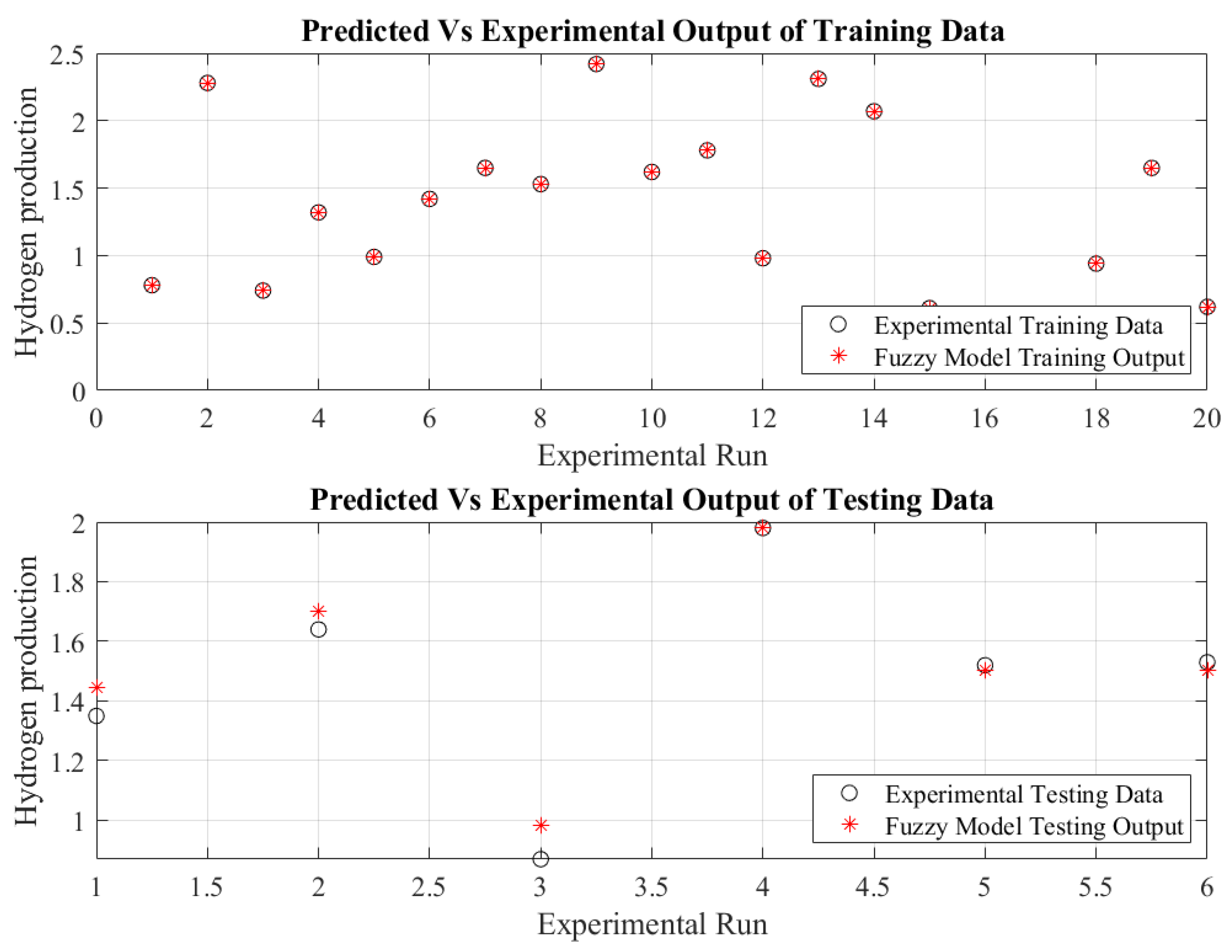
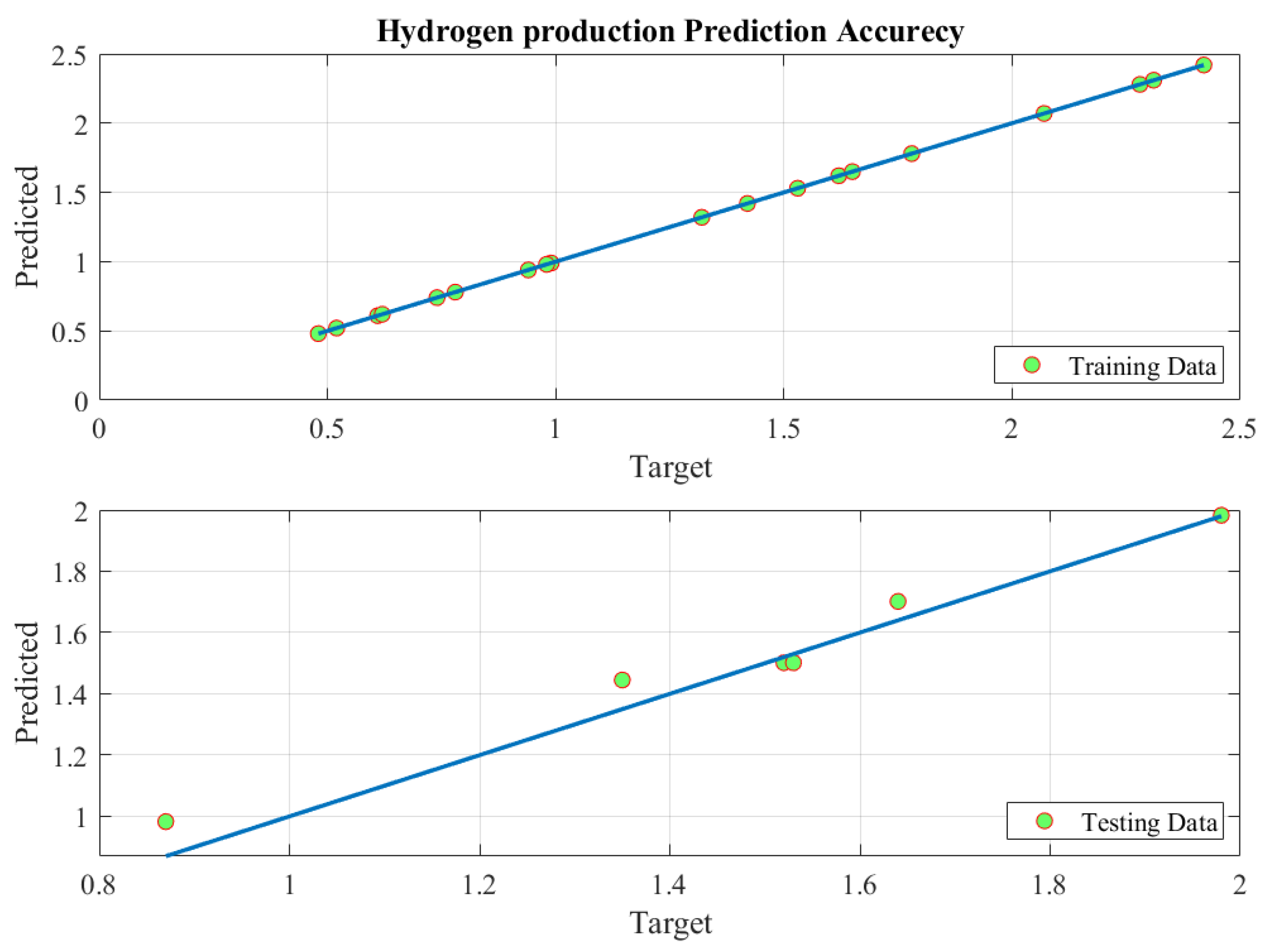

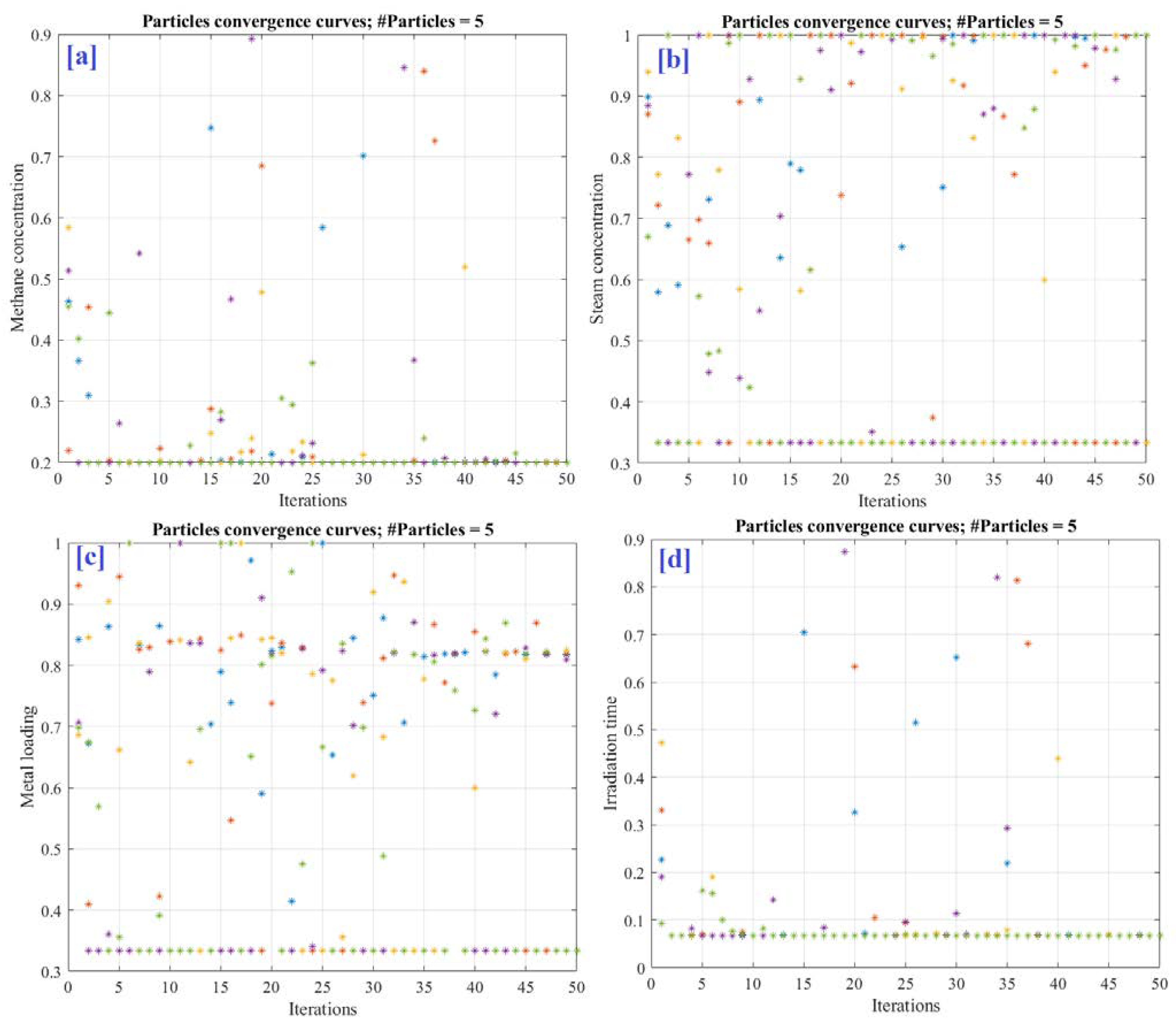
| MSE | RMSE | Coefficient of Determination (R2) | ||||||
|---|---|---|---|---|---|---|---|---|
| Train | Test | All | Train | Test | All | Train | Test | All |
| 4.42E-13 | 0.0045 | 0.001 | 6.64E-07 | 0.0668 | 0.0321 | 1 | 0.981 | 0.997 |
| Algorithm | Parameter Values |
|---|---|
| SMA | z = 0.03 |
| PSO | C1 = 1.5; C2 = 2 |
| HHO | a1 = 2; a2 = 1; GP = 0.5 |
| EESHHO | a1 = 2; a2 = 1; GP = 0.5 |
| Run | PSO | HHO | SMA | EESHHO | Run | PSO | HHO | SMA | EESHHO |
|---|---|---|---|---|---|---|---|---|---|
| 1 | 2.8087 | 2.8089 | 2.8087 | 2.5206 | 16 | 1.882 | 2.8047 | 2.6634 | 2.8089 |
| 2 | 2.8088 | 2.4544 | 2.8089 | 2.664 | 17 | 2.8088 | 2.6567 | 2.4877 | 2.8089 |
| 3 | 2.664 | 2.675 | 2.8089 | 2.8082 | 18 | 2.8088 | 2.8089 | 2.8087 | 2.8089 |
| 4 | 2.6639 | 2.8089 | 2.664 | 2.664 | 19 | 2.8088 | 2.7187 | 2.8088 | 2.7418 |
| 5 | 2.8089 | 2.8089 | 2.6638 | 2.6326 | 20 | 2.5208 | 2.7711 | 2.664 | 2.6606 |
| 6 | 2.797 | 2.7976 | 2.5183 | 2.5512 | 21 | 2.8081 | 2.8039 | 2.5191 | 2.8089 |
| 7 | 2.664 | 2.8089 | 2.8089 | 2.6123 | 22 | 2.664 | 2.8089 | 2.6639 | 2.664 |
| 8 | 2.5196 | 2.8089 | 2.5204 | 2.664 | 23 | 2.8088 | 2.3998 | 2.8088 | 2.5209 |
| 9 | 2.5187 | 2.389 | 2.5206 | 2.7394 | 24 | 1.874 | 2.664 | 2.664 | 2.5209 |
| 10 | 2.8088 | 2.6892 | 2.8089 | 2.6136 | 25 | 2.8087 | 2.7792 | 2.8082 | 2.6258 |
| 11 | 2.8085 | 2.727 | 2.8088 | 2.6115 | 26 | 2.8084 | 2.4152 | 2.8078 | 2.7358 |
| 12 | 2.5207 | 2.688 | 2.664 | 2.6444 | 27 | 2.8066 | 2.8076 | 2.8089 | 2.5167 |
| 13 | 2.1936 | 2.618 | 2.6639 | 2.679 | 28 | 2.8082 | 2.3131 | 2.8087 | 2.8089 |
| 14 | 2.8089 | 2.664 | 2.5115 | 2.4188 | 29 | 2.8066 | 2.6634 | 2.8089 | 2.8088 |
| 15 | 2.8089 | 2.664 | 2.6639 | 2.664 | 30 | 2.664 | 2.8035 | 2.664 | 2.5852 |
| PSO | HHO | SMA | EESHHO | |
|---|---|---|---|---|
| Best | 2.80886 | 2.80886 | 2.80886 | 2.80886 |
| Worst | 1.87399 | 2.31314 | 2.48765 | 2.4188 |
| Mean | 2.66299 | 2.68764 | 2.70128 | 2.66375 |
| STD | 0.25246 | 0.14571 | 0.1139 | 0.11597 |
| Variance | 0.06374 | 0.02123 | 0.01297 | 0.01123 |
| Median | 2.80735 | 2.72283 | 2.66404 | 2.66404 |
Publisher’s Note: MDPI stays neutral with regard to jurisdictional claims in published maps and institutional affiliations. |
© 2022 by the authors. Licensee MDPI, Basel, Switzerland. This article is an open access article distributed under the terms and conditions of the Creative Commons Attribution (CC BY) license (https://creativecommons.org/licenses/by/4.0/).
Share and Cite
Nassef, A.M.; Handam, A. Parameter Estimation-Based Slime Mold Algorithm of Photocatalytic Methane Reforming Process for Hydrogen Production. Sustainability 2022, 14, 2970. https://doi.org/10.3390/su14052970
Nassef AM, Handam A. Parameter Estimation-Based Slime Mold Algorithm of Photocatalytic Methane Reforming Process for Hydrogen Production. Sustainability. 2022; 14(5):2970. https://doi.org/10.3390/su14052970
Chicago/Turabian StyleNassef, Ahmed M., and Ahmed Handam. 2022. "Parameter Estimation-Based Slime Mold Algorithm of Photocatalytic Methane Reforming Process for Hydrogen Production" Sustainability 14, no. 5: 2970. https://doi.org/10.3390/su14052970
APA StyleNassef, A. M., & Handam, A. (2022). Parameter Estimation-Based Slime Mold Algorithm of Photocatalytic Methane Reforming Process for Hydrogen Production. Sustainability, 14(5), 2970. https://doi.org/10.3390/su14052970







